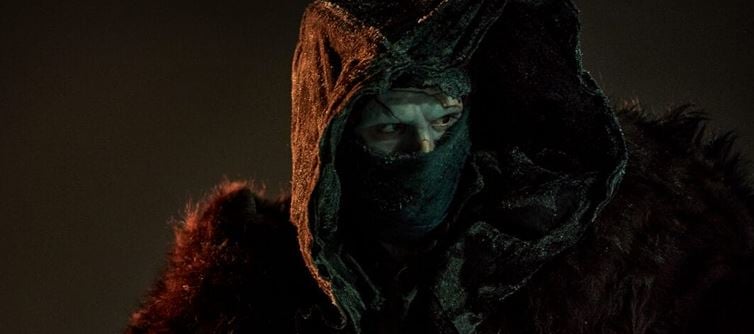
🧬 STORY
Guillermo del Toro’s Frankenstein begins not in the comfort of a laboratory but amid the freezing wilderness of 1857. Captain Anderson (Lars Mikkelsen), leading a Danish navy expedition, stumbles upon a battered, dying Victor Frankenstein (Oscar Isaac). But Victor isn’t alone — he’s being hunted by a terrifying figure (Jacob Elordi), part man, part myth.
What unfolds next isn’t just a chase between creator and creation, but a tragic exploration of guilt, godhood, and the unbearable loneliness of being alive.
As the Monster’s story unravels, del Toro transforms Mary Shelley’s gothic terror into an emotional epic — one that sees the Creature not as a villain, but as a victim of human hubris.
The film moves between horror, melancholy, and redemption, crafting a tale that’s as visually haunting as it is spiritually moving.
🎭 PERFORMANCES
oscar Isaac plays Victor Frankenstein with the perfect balance of brilliance and torment. He embodies the arrogance of a man blinded by ambition — a scientist who creates life only to recoil from it. Isaac’s subtle expressions and bursts of madness bring nuance to a role that could easily have become theatrical.
Yet it’s Jacob Elordi who commands the screen. Beneath heavy prosthetics, Elordi’s Creature exudes both rage and ruin, shifting effortlessly from terrifying to tragically tender. His physicality — the way he moves, breathes, and stumbles through his newfound existence — captures the pain of a being denied humanity.
Mia Goth shines in a small but pivotal role as Elizabeth, embodying purity and compassion in a world drenched in cruelty. And David Bradley, as the blind old man who briefly shelters the Monster, delivers one of the film’s most heartbreakingly humane performances.
Together, this cast becomes del Toro’s chorus — each voice carrying a note of sorrow and empathy that lingers long after the credits fade.
🎬 TECHNICALITIES
Cinematographer Dan Lausten, reuniting with del Toro, turns every frame into a painting. The film glows with gothic grandeur — from the turquoise glint of frozen waters to the soft candlelight illuminating Victor’s decaying laboratory.
There’s a dreamlike movement to the camera — it floats through halls, glides across snow, and breathes with the characters, creating an immersive, almost operatic rhythm.
The production design is masterful — the rusted lab equipment, the crumbling estates, the tattered books, and the candlelit corridors all evoke the decaying beauty of 19th-century Europe. Every visual detail serves the story, reflecting themes of rot, resurrection, and rebirth.
Costumes drape the film in luxury and sorrow, while the color palette — emeralds, blood reds, and ghostly whites — feels like the emotional heartbeat of the movie itself.
And of course, del Toro’s signature touch: practical effects and prosthetics that make Elordi’s Monster a living, breathing marvel of tragedy and terror.
The score, with its haunting strings and soft choral echoes, feels like a requiem for the living — melancholic, grand, and utterly unforgettable.
💔 ANALYSIS
Guillermo del Toro’s Frankenstein is less a horror film and more a confession of compassion.
At its heart lies the eternal struggle — the desire to create, the pain of rejection, and the search for meaning in imperfection. Del Toro reimagines Shelley’s narrative as a spiritual dialogue between maker and made, between humanity and its mistakes.
The film’s emotional core lies in its quietest sequences — the Monster learning poetry from his blind mentor, or watching snowfall for the first time.
Del Toro lets us see the Creature’s soul — yearning, learning, suffering — in a world that only sees his scars.
By the time the Monster learns that he was created not out of love but from arrogance, the heartbreak is unbearable.
Victor’s punishment is not death — it’s living long enough to see the monster in himself.
The final act feels both intimate and immense — a confrontation not just of man versus monster, but of guilt versus grace.
Del Toro brings the myth full circle, transforming horror into empathy and despair into transcendence.
✅ WHAT WORKS
• Guillermo del Toro’s emotionally rich direction
• Jacob Elordi’s haunting, heartbreaking performance
• oscar Isaac’s controlled madness as Victor
• Dan Lausten’s painterly cinematography and lighting
• Emotional depth and faithfulness to Shelley’s spirit
• Breathtaking production and costume design
• Gothic mood and intelligent use of symbolism
❌ WHAT DOESN’T
• The pursuit between Victor and the Creature feels a bit rushed• Some deviations from the novel may frustrate purists
• Emotional pacing is slightly uneven in the final 20 minutes
🎯 BOTTOM LINE
Guillermo del Toro’s Frankenstein is a breathtaking fusion of horror and humanity — a darkly poetic masterpiece that finds compassion in the grotesque and beauty in the broken.
It’s as much about life and loss as it is about the monsters we make — both in our labs and within ourselves.
A visual poem of pain and creation — and a reminder that sometimes, the most human thing about us is our imperfection.
🎞️ Final Rating Breakdown:
| Category | Score |
|---|---|
| Story & Screenplay | 9/10 |
| Performances | 9.5/10 |
| Direction | 9.5/10 |
| Cinematography | 10/10 |
| Production Design | 9.5/10 |
| Emotional Impact | 9/10 |
| Rewatch Value | 8.5/10 |
India Herald Percentage Meter - 91%




 click and follow Indiaherald WhatsApp channel
click and follow Indiaherald WhatsApp channel